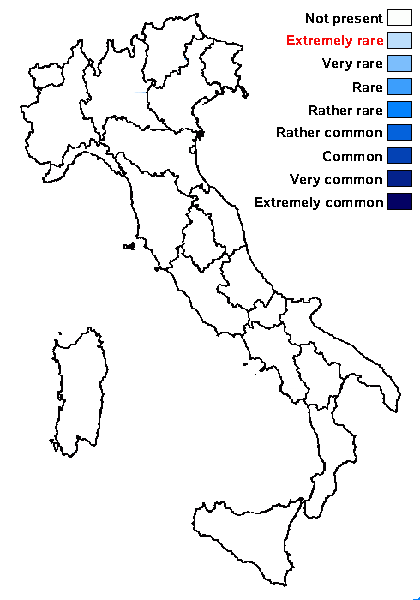Loxospora chloropolia (Erichsen) Ptach-Styn, Guzow-Krzem., Tønsberg & Kukwa
Mycokeys, 102: 170, 2024. Basionym: Pertusaria chloropolia Erichsen - in Zahlbr., Rabenhorst. Krypt.-Fl., Ed. 2, 9, 5: 645, 1935 (1936)
Synonyms: Pertusaria chloropolia f. cana Erichsen
Distribution:
Description: Thallus crustose, thinly episubstratic, grey, matt or more often shiny, continuous, slightly folded or rimose, more rarely rimose-areolate, the areoles flat to rarely slightly convex and not constricted at base. Soralia whitish to greenish-grey, flat or more often convex, rounded to irregular, mostly discrete, bursting from flat parts of thallus or from areoles, sometimes crowded and coalescing, but the boundaries between them often visible, very rarely fused into irregular patches in older parts of thallus. Soredia up to 50 μm in diam., often gathered into up to 100 μm wide consoredia. Apothecia very rare, lecanorine, single, up to 1.2 mm across, with a reddish brown, faintly white-pruinose, flat to finally convex disc and a thin, often sorediate thalline margin. Proper exciple poorly evident; epithecium yellowish brown, K+ pale reddish brown, with dense granules dissolving in K; hymenium colourless, up to 100 μm high, I+ blue; paraphyses mostly simple, rather lax, not or only slightly swollen at tips; hypothecium colourless to pale brown. Asci 8-spored, with a uniformly amyloid apical dome. Ascospores (0-)3(-5)-septate, coiled in the asci, hyaline, fusiform, curved, 35-48 x 5-7 μm. Photobiont chlorococcoid, the cells up to 12 μm wide. Spot tests: thallus and soralia K+ rapidly bright lemon yellow, C-, KC- or KC+ yellow, P+ yellow-orange, UV-. Chemistry: thamnolic acid (major), elatinic acid (minor, trace or absent) and squamatic acid (trace or absent).
Note: a species described from Switzerland and known from rom Czechia, Great Britain, Latvia, Norway, Poland, Sweden and the Ukraine, long considered as a synonym of L. elatina, from which it differs in both morphology and molecular data (see Ptach-Styn & al. 2024). It grows on bark in humid mixed forests. To be looked for in Italy.
Growth form: Crustose
Substrata: bark
Photobiont: green algae other than Trentepohlia
Reproductive strategy: mainly asexual, by soredia, or soredia-like structures (e.g. blastidia)

Predictive model
Growth form: Crustose
Substrata: bark
Photobiont: green algae other than Trentepohlia
Reproductive strategy: mainly asexual, by soredia, or soredia-like structures (e.g. blastidia)

Predictive model


